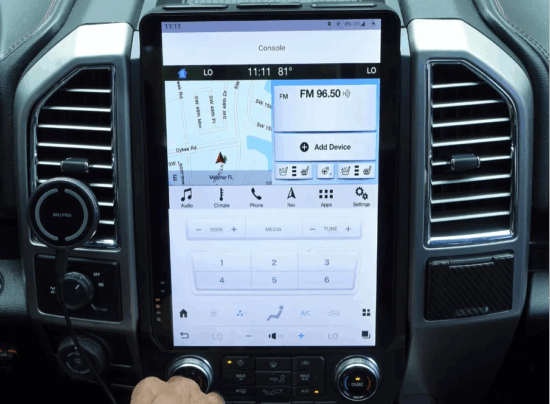Introduction
The Ford F-350 is a workhorse of a truck, designed for heavy-duty tasks and built to endure the most demanding driving conditions. While its performance and durability are unquestionable, one area that often needs improvement in older models is the in-cabin technology — especially the stereo system. A modern stereo upgrade isn’t just a luxury; it’s an investment in comfort, safety, and connectivity. Whether you’re using your F-350 for hauling loads, towing equipment, or long-distance drives, upgrading your stereo can dramatically enhance your driving experience. In this guide, we’ll walk through the benefits, options, and process of upgrading your Ford F-350’s stereo system.
Why Upgrade Your F-350 Stereo System?
Older trucks often come with limited or outdated infotainment systems that fall behind modern standards. Today’s drivers expect seamless integration with their smartphones, access to streaming apps, real-time navigation, and responsive touchscreen interfaces.
Outdated Technology
Factory-installed stereos, especially those in pre-2017 models, often lack features like Apple CarPlay, Android Auto, and touchscreen navigation. Using such a system is like trying to navigate today’s digital world with a pager.
Modern Features
A good stereo upgrade brings features like voice control, real-time traffic updates, streaming services, Bluetooth calling, and text messaging capabilities right to your dashboard.
Improved Audio Quality
Aftermarket stereos typically offer better audio processing, EQ settings, and more powerful output — perfect for music lovers or anyone who wants to enjoy clear audio while on the road.
Increased Resale Value
Tech upgrades add value. Potential buyers appreciate seeing a modern infotainment setup, especially in a truck that already holds its value well.
Common Signs Your Stereo Is Due for a Change
Here are clear indicators that your current system may be falling short:
– No Bluetooth or smartphone integration.
– Glitchy interface or slow response time.
– Poor screen resolution and small display size.
– Outdated maps or missing GPS.
– Limited audio customization or weak sound.
– Compatibility issues with newer phones or devices.
Key Features to Look For in an Aftermarket Stereo
Full Integration
The new system should retain OEM functions like climate control, steering wheel controls, rearview camera, and factory amplifiers.
Apple CarPlay & Android Auto
These allow you to mirror your smartphone on the screen, access navigation apps, respond to messages hands-free, and play your music playlists.
High-Resolution Touchscreen
Go for displays larger than 9 inches. Some units offer vertical Tesla-style screens, which provide both style and functionality.
Speed & Storage
Look for systems with quad-core or octa-core processors and at least 2GB of RAM. Built-in storage allows you to download apps, store maps, and save media.
Software Support
Ensure the system supports over-the-air (OTA) updates and app downloads via the Play Store or other platforms.
Installation Options: DIY vs. Professional
Some stereo upgrades come as complete kits with plug-and-play harnesses, making DIY installation possible for those with basic automotive knowledge. However, improper installation can lead to malfunctioning electronics, dashboard fitment issues, or even damage to your truck’s wiring.
DIY Installation
Ideal for tech-savvy owners. Most kits include the necessary tools, brackets, and manuals. However, you’ll still need to set aside 2–4 hours and have a basic understanding of car electronics.
Professional Installation
Recommended if you’re unsure or want guaranteed results. A certified car audio specialist ensures everything works perfectly and can troubleshoot any integration issues on the spot.
Long-Term Benefits of a Modern Stereo
An upgraded stereo goes beyond just convenience. Here’s what you’ll enjoy day-to-day:
– Easier access to apps, calls, and media.
– Voice-guided navigation and traffic alerts.
– Support for streaming services like Spotify, Pandora, and YouTube Music.
– A visually appealing interior with modern aesthetics.
– Future-proofing with software upgrades and compatibility with newer devices.
– Better safety through hands-free controls and reduced distraction.
How to Choose the Right Stereo System
With so many models on the market, it’s important to select a stereo that fits both your F-350 model and your personal preferences. Consider the following:
Model Year Compatibility
Some systems are tailored for specific year ranges (e.g., 2011–2016), while others are more universal.
Dashboard Fitment
Ensure the screen size and shape fit your truck’s console without needing modifications.
Feature Set
Don’t overpay for features you won’t use, but make sure you get the ones that matter most to you.
Customer Support
Choose a brand that offers reliable customer service, firmware updates, and a solid warranty policy.
Frequently Asked Questions
Q: Will I lose factory functions like backup camera or steering wheel controls?
A: Not if you choose a system that supports OEM integration. Many aftermarket stereos are designed to work seamlessly with factory features.
Q: Is a stereo upgrade worth the cost?
A: Absolutely — especially if you plan to keep your truck for several more years. The improved experience is noticeable daily.
Q: How long does installation take?
A: A professional can typically complete the job in 1–2 hours. DIY installs may take longer depending on your experience level.
Conclusion
The Ford F-350 is built to perform — but performance doesn’t have to stop under the hood. Upgrading your stereo system is one of the easiest ways to bring your truck up to speed with modern technology. From seamless connectivity and smarter navigation to enhanced aesthetics and resale value, the benefits are clear. Whether you choose to tackle the upgrade yourself or trust a professional, a modern stereo will breathe new life into your driving experience.



Did I accidentally enter a Ford truck site ? Must have been the long Memorial Day weekend.